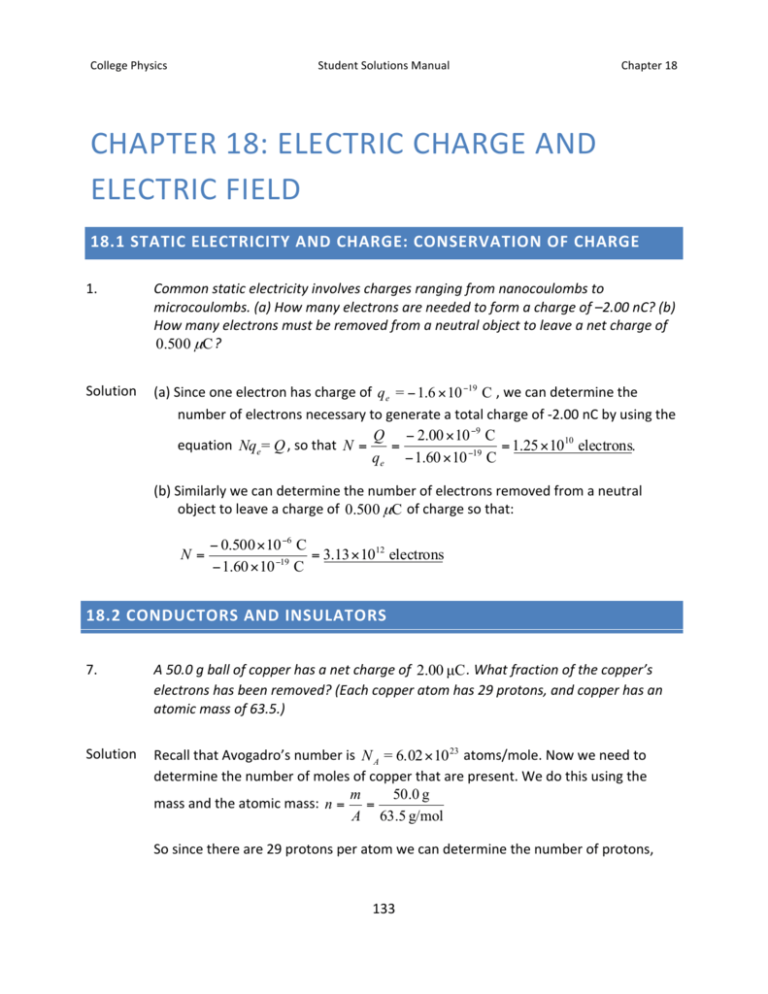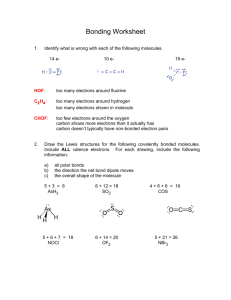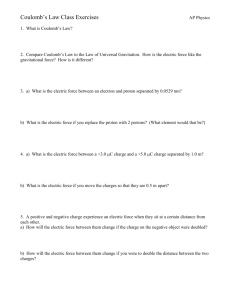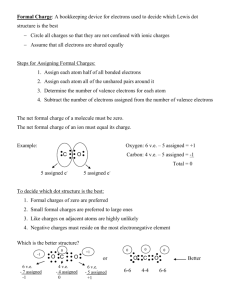CHAPTER 18: ELECTRIC CHARGE AND ELECTRIC FIELD
advertisement

College Physics Student Solutions Manual Chapter 18 CHAPTER 18: ELECTRIC CHARGE AND ELECTRIC FIELD 18.1 STATIC ELECTRICITY AND CHARGE: CONSERVATION OF CHARGE 1. Common static electricity involves charges ranging from nanocoulombs to microcoulombs. (a) How many electrons are needed to form a charge of –2.00 nC? (b) How many electrons must be removed from a neutral object to leave a net charge of 0.500 µC ? Solution (a) Since one electron has charge of q e = − 1.6 × 10 −19 C , we can determine the number of electrons necessary to generate a total charge of -­‐2.00 nC by using the Q − 2.00 × 10 −9 C equation Nqe= Q , so that N = = = 1.25 × 1010 electrons. −19 qe − 1.60 × 10 C (b) Similarly we can determine the number of electrons removed from a neutral object to leave a charge of 0.500 µC of charge so that: N= − 0.500 × 10 −6 C = 3.13 × 1012 electrons − 1.60 × 10 −19 C 18.2 CONDUCTORS AND INSULATORS 7. A 50.0 g ball of copper has a net charge of 2.00 µC . What fraction of the copper’s electrons has been removed? (Each copper atom has 29 protons, and copper has an atomic mass of 63.5.) Solution Recall that Avogadro’s number is N A = 6.02 × 10 23 atoms/mole. Now we need to determine the number of moles of copper that are present. We do this using the m 50.0 g mass and the atomic mass: n = = A 63.5 g/mol So since there are 29 protons per atom we can determine the number of protons, 133 College Physics Student Solutions Manual Chapter 18 N p , from: N p = nN A × 29 protons/atom ⎛ 50.0 gm ⎞⎛ 6.02 × 10 23 atoms ⎞ 29 protons ⎟⎟ × ⎟⎟⎜⎜ = ⎜⎜ = 1.375 × 10 25 protons mol ⎝ 63.5 g/mol ⎠⎝ ⎠ cu atom Since there is the same number of electrons as protons in a neutral atom, before we remove the electrons to give the copper a net charge, we have 1.375× 10 25 electrons. Next we need to determine the number of electrons we removed to leave a net charge of 2.00 µC . We need to remove − 2.00 µC of charge, so the number of electrons to be removed is given by N e,removed = Q − 2.00 × 10 −6 C = = 1.25 × 1013 electrons removed. −19 qe − 1.60 × 10 C Finally we can calculate the fraction of copper’s electron by taking the ratio of the number of electrons removed to the number of electrons originally present: N e, removed N e,initially 1.25 × 10 13 = = 9.09 × 10 −13 25 1.375 × 10 18.3 COULOMB’S LAW 13. Solution Two point charges are brought closer together, increasing the force between them by a factor of 25. By what factor was their separation decreased? Using the equation F1 = k q1 q 2 r1 2 , we see that the force is inversely proportional to the separation distance squared, so that F1 = K q1q2 qq and F2 = K 1 22 2 r1 r2 Since we know the ratio of the forces we can determine the ratio of the separation 2 r F1 1 1 F ⎛ r ⎞ distances: 1 = ⎜⎜ 2 ⎟⎟ so that 2 = = = r1 F2 25 5 F2 ⎝ r1 ⎠ The separation decreased by a factor of 5. 134 College Physics 20. Student Solutions Manual Chapter 18 (a) Common transparent tape becomes charged when pulled from a dispenser. If one piece is placed above another, the repulsive force can be great enough to support the top piece’s weight. Assuming equal point charges (only an approximation), calculate the magnitude of the charge if electrostatic force is great enough to support the weight of a 10.0 mg piece of tape held 1.00 cm above another. (b) Discuss whether the magnitude of this charge is consistent with what is typical of static electricity. Solution (a) If the electrostatic force is to support the weight of 10.0 mg piece of tape, it must be a force equal to the gravitational force on the tape, so using the equation qq F1 = k 1 2 2 and the assumption that the point charges are equal, we can set r1 electrostatic force equal to gravitational force. ⎛ r 2 mg ⎞ qq kq 2 ⎟⎟ F = k 1 2 2 = 2 = mg ⇒ q = ⎜⎜ r r ⎝ k ⎠ 1/ 2 ⎡ (0.0100 m )2 (10.0 × 10 −6 kg )(9.80 m/s 2 )⎤ = ⎢ ⎥ (9.00 × 10 9 N ⋅ m 2 /C 2 ) ⎣ ⎦ 1/ 2 = 1.04 × 10 −9 C. (b) This charge is approximately 1 nC, which is consistent with the magnitude of the charge of typical static electricity. 25. Point charges of 5.00 µC and − 3.00 µC are placed 0.250 m apart. (a) Where can a third charge be placed so that the net force on it is zero? (b) What if both charges are positive? Solution (a) We know that since the negative charge is smaller, the third charge should be placed to the right of the negative charge if the net force on it to be zero. So if we qq want Fnet = F1 + F2 = 0 , we can use the equation F1 = k 1 2 2 to write the forces r1 in terms of distances: ⎛ q q ⎞ Kq1q2 Kq2 q + 2 = Kq⎜⎜ 12 + 22 ⎟⎟ = 0 , or since r1 = 0.250 m + d and r2 = d , 2 r1 r2 ⎝ r1 r2 ⎠ 5 × 10 −6 C 3 × 10 −6 3 = , or d = (0.250 m) + 3 d so that 2 2 d 5 5 (0.250 m + d ) 135 College Physics Student Solutions Manual ⎛ 3 ⎞ 3 ⎟ = (0.250 m) and finally, d = d ⎜⎜1 − ⎟ 5 5 ⎝ ⎠ Chapter 18 3 (0.250 m ) 5 = 0.859 m 3 1− 5 The charge must be placed at a distance of 0.859 m to the far side of the negative charge. (b) This time we know that the charge must be placed between the two positive charges and closer to the 3 µC charge for the net force to be zero. So if we want qq Fnet = F1 + F2 = 0 , we can again use F1 = k 1 2 2 to write the forces in terms of r1 ⎛ q q ⎞ Kq q Kq q distances: 12 2 + 22 = Kq⎜⎜ 12 + 22 ⎟⎟ = 0 r1 r2 ⎝ r1 r2 ⎠ Or since r1 = 0.250m − r2 5 × 10 −6 C 3 × 10 −6 , or = 2 (0.250 − r2 )2 r2 3 (0.250 m − r2 )2 , or r2 = 3 (0.250 m − r2 ) , and finally 5 5 3 (0.250 m ) 5 r2 = = 0.109 m 3 1+ 5 2 r2 = The charge must be placed at a distance of 0.109m from the 3 µC charge. 18.4 ELECTRIC FIELD: CONCEPT OF A FIELD REVISITED 32. (a) Find the direction and magnitude of an electric field that exerts a 4.80 × 10 −17 N westward force on an electron. (b) What magnitude and direction force does this field exert on a proton? Solution (a) Using the equation F = qE we can find the electric field caused by a given force on a given charge (taking eastward direction to be positive): E= F − 4.80 × 10 −17 C = = 300 N/C (east) q − 1.60 × 10 −19 C 136 College Physics Student Solutions Manual Chapter 18 (b) The force should be equal to the force on the electron only in the opposite direction. Using F = qE we get ( ) F = qE = 1.60 × 10 −19 C (300 N/C) = 4.80 × 10 −17 N (east) , as we expected. 18.5 ELECTRIC FIELD LINES: MULTIPLE CHARGES 33. (a) Sketch the electric field lines near a point charge + q . (b) Do the same for a point charge − 3.00 q . Solution (a) +q (b) – 3q 34. Sketch the electric field lines a long distance from the charge distributions shown in Figure 18.26(a) and (b). Solution (a) – 2q 137 College Physics Student Solutions Manual Chapter 18 (b) field of two opposite charges No net charge is seen from far away. 18.7 CONDUCTORS AND ELECTRIC FIELDS IN STATIC EQUILIBRIUM 37. Sketch the electric field lines in the vicinity of the conductor in Figure 18.48, given the field was originally uniform and parallel to the object’s long axis. Is the resulting field small near the long side of the object? Solution – – – – –– – – + – + + ++ + + + + The field lines deviate from their original horizontal direction because the charges within the object rearrange. The field lines will come into the object perpendicular to the surface and will leave the other side of the object perpendicular to the surface. Yes, the field is smaller near the long side of the object. This is evident because there are fewer field lines near the long side of the object and there are more field lines near the point of the object. 44. (a) Find the total Coulomb force on a charge of 2.00 nC located at x = 4.00 cm in Figure 18.52(b), given that q = 1.00 µC . (b) Find the x-­‐position at which the electric field is zero in Figure 18.52(b). Solution (a) According to Figure 18.52, the point charges are given by q1 = −2.00 µC at x = 1.00 cm; q5 = +1.00 µC at x = 5.00 cm; q8 = 3.00 µC at x = 8.00 cm and q14 = −1.00 µC at x = 14.0 cm If a 2 nC charge is placed at x = 4.00 cm, the force it feels from other charges is 138 College Physics Student Solutions Manual Chapter 18 Kq1q . The net force is the vector addition of the r12 force due to each point charge, but since the point charges are all along the x-­‐ axis, the forces add like numbers; thus the net force is given by found from the equation F = F= ⎛ q q q q ⎞ Kq1q Kq5 q Kq8 q Kq14 q − 2 − 2 − 2 = Kq⎜⎜ 12 − 25 − 82 − 142 ⎟⎟ 2 r1 r5 r8 r14 ⎝ r1 r5 r8 r14 ⎠ To the right, notice that the term involving the charge q1 has the opposite sign because it pulls in the opposite direction than the other three charges. Substituting in the values given: ⎛ 9.00 × 10 9 N.m 2 ⎞ ⎟⎟ 2.00 × 10 −9 C × F = ⎜⎜ 2 C ⎝ ⎠ ( ) ⎡ ⎤ − 2.00 × 10 −6 C 1.00 × 10 −6 C 3.00 × 10 −6 C − − ⎢ 2 2 2 ⎥ (0.0500 m − 0.0400 m ) (0.0800 m − 0.0400 m ) ⎥ ⎢ (0.0400 m − 0.0100 m ) − 6 ⎥ ⎢ − 1.00 × 10 C ⎢− ⎥ 2 ⎢⎣ (0.140 m − 0.0400 m ) ⎥ (b) The only possible location where the total electric field could be zero is between ⎦ = -a0.252 N(right) or 0.252 Nrto the tleft 5.00 nd 8.00 cm, since in that ange he closest charges create forces on the test charge in opposite directions. So that is the only region we will consider. For the total electric field to be zero between 5.00 and 8.00 cm, we know that: Kq Kq Kq Kq E = 2 1 + 2 5 − 2 8 − 214 = 0 r1 r5 r8 r14 Dividing by common factors and ignoring units (but remembering x has a unit of cm), we can get a simplified expression: ⎡ −2 1 3 − 1 ⎤ + − − ⎢ y = 2 2 2 2 ⎥ ( ) ( ) ( ) ( ) x − 1 x − 5 x − 8 x − 14 ⎣ ⎦ We can graph this function, using a graphing calculator or graphing program, to determine the values of x that yield y = 0 . Therefore the total electric field is zero at x = 6.07 cm . 139 College Physics 50. Student Solutions Manual Chapter 18 (a) Find the electric field at the center of the triangular configuration of charges in Figure 18.54, given that qa = + 2.50 nC , qb = 8.00 nC , and qc = + 1.50 nC . (b) Is there any combination of charges, other than qa = qb = qc , that will produce a zero strength electric field at the center of the triangular configuration? Solution (a) To determine the electric field at the center, we first must determine the distance from each of the charges to the center of the triangle. Since the triangle is equilateral, the center of the triangle will be halfway across the base and 1/3 of the way up the height. To determine the height use the Pythagorean theorem, or the height is given by h = (25.0 cm )2 − (12.5 cm )2 = 21.7 cm . So the distance from each charge to the center of the triangle is 2/3 of 21.7 cm, or 2 Q r = (21.7 cm ) = 14.4 cm. Since E = k 2 , 3 r ⎛ 2.50 × 10 −9 C ⎞ qa 9 2 2 ⎟ = 1085 N/C at a 90° angle Ea = k 2 = 9.00 × 10 N ⋅ m /C ⎜⎜ 2 ⎟ r ⎝ (0.144 m) ⎠ below the horizontal, ⎛ − 8.00 × 10 −9 C ⎞ q ⎟ = 3472 N/C at a 30° angle E b = k 2b = (9.00 × 10 9 N ⋅ m 2 /C 2 )⎜⎜ 2 ⎟ r ( ) 0 . 144 m ⎝ ⎠ below the horizontal, and ⎛ 1.50 × 10 −9 C ⎞ q ⎟ = 681.0 N/C at a 30° angle Ec = k 2c = 9.00 × 10 9 N ⋅ m 2 /C 2 ⎜⎜ 2 ⎟ r ⎝ (0.144 m) ⎠ above the horizontal. Adding the vectors by components gives: ( ) ( ) E x = Ea cos(− 90°) + E b cos(− 30°) + Ec cos 30° E x = 0 N/C + 3472 N/C (0.860) + 681.0 N/C (0.8660) = 3597 N/C E y = Ea sin (− 90°) + E b sin (− 30°) + Ec sin 30° E y = −1085 N/C - 3472 N/C (0.5000) + 681 N/C (0.5000) = −2481 N/C So that the electric field is given by: 2 2 E = Ex + E y = θ = tan −1 Ey Ex = tan −1 (3597 N/C)2 + (− 2481 N/C)2 = 4370 N/C and − 2481 N/C = −34.6° , or E = 4.37 × 10 3 N/C, 34.6° 3597 N/C below the horizontal. (b) No, there are no combinations other than qa = qb = qc that will produce a 140 College Physics Student Solutions Manual Chapter 18 zero strength field at the center of the triangular configuration because of the vector nature of the electric field. Consider the two cases: (1) all charges have the same sign and (2) one charge have a different sign than the other two. For case (1), symmetry dictates that the charges must be all the same magnitude, if a test charge is not to feel a force at the center of the triangle. For case (2), a positive test charge would feel a force towards the negative charge(s) and away from the positive charge(s). Therefore there is no combination that would produce a zero strength electric field at the center of the triangle. 18.8 APPLICATIONS OF ELECTROSTATICS 56. What can you say about two charges q1 and q2 , if the electric field one-­‐fourth of the way from q1 to q2 is zero? Solution If the electric field is zero 1/4 from the way of q1 and q2 , then we know from the 2 equation E = k q (3x ) Q Kq Kq2 that E1 = E2 ⇒ 21 = so that 2 = 2 = 9 2 2 q1 x x r (3x ) The charge q2 is 9 times larger than q1 . 65. Solution Unreasonable Results (a) Two 0.500 g raindrops in a thunderhead are 1.00 cm apart when they each acquire 1.00 mC charges. Find their acceleration. (b) What is unreasonable about this result? (c) Which premise or assumption is responsible? (a) To determine the acceleration, use Newton's Laws and the equation F = k F = ma = kq1 q 2 ⇒ r2 ( 2 )( 2 ) 9.00 ×10 9 N ⋅ m 2 C 1.00 ×10 −3 C kq 2 a= 2 = =1.80 ×1011 m s 2 2 −3 mr 0.500 ×10 kg (0.0100 m ) ( ) q1 q 2 : r2 (b) The resulting acceleration is unreasonably large; the raindrops would not stay together. (c) The assumed charge of 1.00 mC is much too great; typical static electricity is on the order of 1 µC or less. 141







